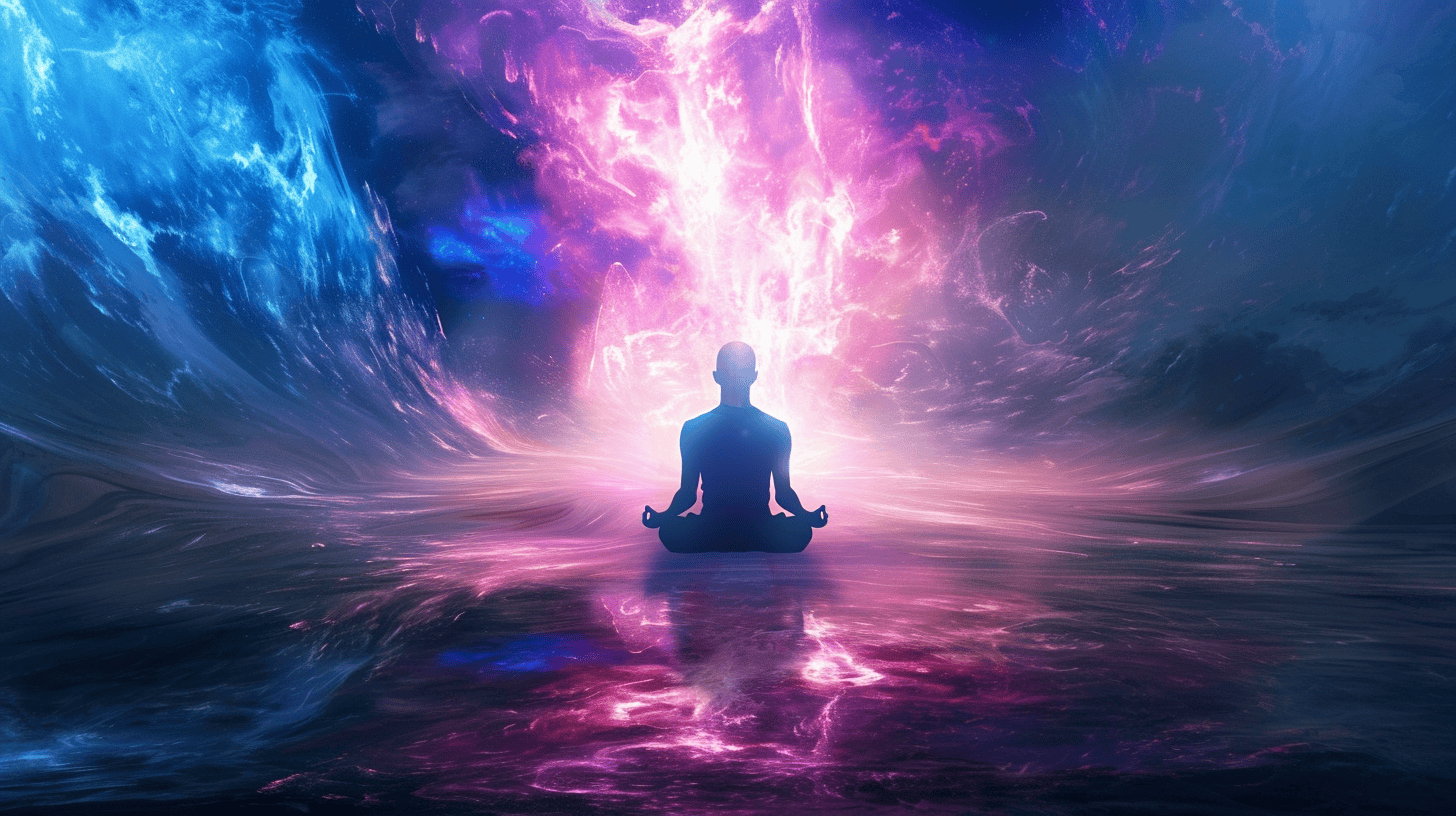I have found that mindfulness meditation for enlightenment is one of the most powerful practices for setting us on the path to enlightenment. By cultivating present moment awareness and a nonjudgmental observation of our thoughts and feelings, mindfulness allows us to gain insight into the nature of reality and free ourselves from destructive patterns.
As someone newer to meditation, I started my practice by taking 10 minutes in the morning to sit quietly and focus on my breath. Paying close attention to the sensations of each inhalation and exhalation helped calm my mind. When it wanders, I gently return my attention back to my breath. This simple mindfulness technique taught me how to become more aware of my present experience.
Overall, a regular daily meditation practice combining mindfulness, loving-kindness,concentration, and retreats allows me to become more conscious, awake, and enlightened. Little by little, meditation dissolves the ego and quietens the chatter of thoughts. In those spacious silent moments, insights into our true boundless nature arise.
Key Takeaways:
- Regular meditation practice trains our minds for enlightened perception and changes brain structure to weaken ego fixation
- Mental stillness allows glimpses of higher states showing our true nondual unity with Divine Essence
- Letting go effortlessly happens through cultivating non-attached witnessing presence to realize the emptiness of phenomena
- Subjective feelings of interconnectivity, love, bliss indicate transcendental experiences pointing to enlightenment
- By dissolving illusions that create separation life becomes a flow of compassionate creativity nourishing our shared purpose
Meditation Exercises That Facilitate Enlightenment
While many practices can set us on the holy grail quest of spiritual awakening, these meditation exercises build essential skills leading to enlightenment:
Mindfulness Meditation
This foundational technique develops the muscle of attention. Find a quiet space, sit comfortably with eyes gently closed. Bring full focus to bodily sensations by scanning and relaxing each area for 1-2 minutes. Next, focus on the breath, noticing the subtle feelings at nostrils or expansion of the belly. When the mind wanders, patiently return attention to the breath without judgment. Even 5 minutes daily conditions concentration preparing for enlightenment!
Loving-Kindness Meditation
Systematically sending blessings of happiness, health and peace to self, loved ones, neutral people and difficult individuals or enemies softens reactivity, quieting our judgemental minds. Visualize each beneficiary smiling as this heart-opening practice fills your being with compassion. Metta meditation liquefies ego-boundaries revealing our shared Divinity!
Mantra Repetition
Choose a personally resonant mantra like Om, Om Namah Shivaya, Om Mani Padme Hum or any other sacred syllable representing the Divine Absolute. Silently repeat this mantra continuously for the entire meditation, using a mala rosary to count 108 repetitions with focus on the sound/meaning. This concentrates wavering minds while creating blissful absorption in the sacred presence mantras invoke.
Guru Yoga
Visualize sitting before your spiritual ideal: a living teacher, enlightened being like Buddha or embodiment of Divine Virtues. Feel gratitude and devotion as you receive transmission of grace. Merge your mind with their enlightened state through dissolving into luminosity or resting in the heart. This pivots consciousness toward gnosis using sacred imagery.
The purpose of meditation in seeking enlightenment
The Buddha taught we all have the seed or potential for enlightenment within us. Through meditation, we water that seed by quieting our busy minds absorbed in mundane thoughts and connecting to our deeper nature. Enlightenment represents recognizing the truth of who we actually are.
Daily sitting in meditation trains our attention and awareness. Like building a muscle, it strengthens our capacity to observe reality as it is without our usual projections and interpretations. We create space between our perception and response to see things clearly. This clarity and objectivity allows us to experience the Suchness or True Nature underlying appearances.
“When you sit in meditation practice, your mind and body should be one.” – Buddha
Enlightenment is not about gaining something new but seeing through illusions that prevent us from being aware of what already exists. Meditation helps strip away those illusions so we realize our luminous mind unobscured by mental chatter and ego. No longer hypnotized by habitual thinking and conditioning, we awaken to our boundless Buddha-nature.
Enthusiastic Buddhist highlights the practice of Vipassana Meditation, which involves paying attention to the arising and passing away of sensations in different parts of your body, a technique esteemed in Theravada Buddhist schools for developing insight into our true nature.
Ultimately, the purpose of meditation on the quest for enlightenment is waking up from the dream state of ordinary consciousness preoccupied with small self concerns. By unknotting tensions in body and mind through meditation, we loosen the grip of ego-clinging and directly taste our unity with universal Beingness.
Tip: Remember enlightenment means waking up to what you already are. Meditation helps create spacious awareness to realize this.
How can meditation lead to enlightenment or self-realization
Science suggests regular meditation literally changes our brains in ways that shift perception and support self-realization. MRI scans reveal that meditators have increased cortical thickness in areas linked to sensory processing, awareness, and empathy. Meditation strengthens neural pathways used for attention, introspection and integrating information to see reality clearly.
Neuroscience finds -colored that meditators suppress the default mode network associated with wandering thoughts and self-referential processing. Simultaneously, the frontoparietal control network regulating higher cognitive skills becomes more active. In effect, meditation trains the brain for enlightenment!
Subjectively, by calming our monkey minds through focusing attention on the breath, mantras or awareness itself meditation leads to tranquility. From this serene space, insights about the nature of self and phenomena easily surface. These glimpses or kenshos often come as surprises since conditioned conceptual reality usually eclipses truth.
For instance, concentrating on tactile sensations while washing dishes yesterday, the boundary between my hands and the slick plates vanished. Everything fused into one seamless tactile flow. This experience of oneness or nonduality provided a mini-satori showing my small self to be an illusion created by mental partitioning. Such moments of awakening accumulate to culminate in enlightenment.
So neurologically, psychologically and energetically meditation rewires our being for enlightened perception beyond ego to manifest our Buddha-essence Self union with all existence.
What does it mean to be enlightened and how does meditation facilitate this state
Buddhists define enlightenment or bodhi as awakening from the dream-like illusion of separation to nondual reality where all phenomena interconnect as One Love. Neuroscience describes enlightenment as sustained access to higher brain states marked by profound cognitive flexibility and bliss through the loss of self.
Meditation precipitates enlightenment by allowing consciousness to settle into its underlying silent spacious awareness. As thoughts subside, perception opens into a crystal clarity devoid of all concepts, interpretations and mental filters usually warping how we see reality.
Subjectively this feels like waking up from a frantic dream you never realized you were having. A sense of relief, expansion and peace arises as the knot of tension caused by identification with mental narratives untangles. Suffering evaporates when grasping for desires ceases. Interconnectedness with all beings blossoms into unconditional empathy and compassion. You wake up as boundless pure awareness conscious of itself everywhere while paradoxically empty.
While flashes of this awakened state visit mystics and meditators, stabilization lasts as subsequent realizations destroy latent conditioning. Neuroscience notes consist of EEG signatures at advanced stages with heightened gamma wave activity spiking when entering Samadhi. Meditation calms beta waves linked with thinking and activates synchronized alpha/theta flows indicating deep meditation.
Whatever the level of realization, meditation opens portals beyond normal consciousness to know yourself as infinite spirit. Gradually, you come to actually live an enlightened state continuously.

The stages or levels of enlightenment that can be attained through meditation
While classifications differ, Buddhists delineate four main stages of enlightenment realizable through meditation:
Stream-Enterer
The first glimpse of Nirvana where clinging to self starts dissolving. You enter the stream to Awakening by seeing past-lives and grasping impermanence.
Once-Returner
Further weakening personal identity and craving. Residual ill-will fades. Mastery of Jhana meditative absorptions deepens. You only return to the physical once more after death.
Non-Returner
All sense of self and feelings as a separate subject/object disappear. No more rebirth into conditional realms. You tap into Infinite Unity Consciousness.
Arahant
Full enlightenment snuffing out roots of ignorance and suffering. You become a fully liberated Buddha incarnating pure awareness. Boundless heart overflows with spiritual fruits like bliss, joy, and equanimity.
Through meditation you reach planes from subtle to absolute. Regular practice ripens each stage until ego delusion falls away for good and Buddha Mind fully awakens!
How the practice of meditation allows access to higher states of consciousness related to enlightenment
By calming our busy, conditioned minds, meditation creates space for transcendental states of unity and consciousness associated with enlightenment to unfold.
Silencing our mental chatter by concentrating on an object like the breath, body, or mantra restricts the neural firing pattern called default mode. This opens access to more spacious Alpha and Theta brain frequencies correlated with awakened awareness.
As Nobel prize-winner Francis Crick hypothesized, the loud 40 hz Beta frequency generated from thoughts, emotions, and perception of differentiation must be minimized before consciousness can enter meditative Alpha/Theta fields, unveiling unity.
My own meditation confirms Crick’s theory. Recently, while meditating, my sense of observing thoughts dropped away as my deeper mind became profoundly silent. Instantly, subject/object disappeared into an ocean of pure, undifferentiated consciousness simultaneously empty and aware. This mystical state showed my consciousness can directly plunge into Universal Being-Awareness-Bliss the sages describe.
Though temporary, such glimpses reveal consciousness has innate capacity to enter the Absolute’s ‘Fourth State’ beyond waking, dreaming and sleeping. By allowing consciousness to return to its native non-localized condition, meditation enables access to enlightened presence. So regular meditation is crucial to stabilize and integrate these openings into higher realities leading to full illumination!
Tip: Move into meditative zones by following the breath to quieten the thinking mind. This opens access to awakened awareness.

Role the quieting of thoughts plays in using meditation as a path to enlightenment
Buddhists compare our ordinary, untrained minds to a glass of muddy water. Constant cerebral noise and activity keep consciousness agitated and disturbed. But if left alone, the dirt gradually settles to the bottom, leaving clarity.
Similarly, in meditation, we calm internal turbulence. By repeatedly returning attention to an anchor like the breath whenever the mind wanders, we clarify awareness just like particles sinking down in motionless water. Eventually, all mental activity dies down and only pristine wakefulness looking at itself remains.
My teacher describes four stages of mental quietude:
- Constant distraction
- Occasional distraction
- Breath is only focus
- No distractions or focus
In stage one when I started meditating, my anxious thoughts seemed unstoppable. As I continued practicing meditation daily, I noticed less mind-traffic. Now I can dwell in the calm third stage for some sittings before thoughts arise.
Yet in the rare fourth phase, consciousness becomes like a serene translucent ocean without any ripples or waves. No effort is needed to concentrate since the habit of distraction ends. This utter quietude of all mental processing allows Ultimate Reality to enter direct perception unfiltered by concepts.
So by pacifying thought-currents, meditation incubates the serenity for glimpses of enlightened awareness as Absolute Consciousness beyond persona to transpire. Gradually, these glimpses cohere into a stable realisation encapsulating both supreme quiescence and cognizance simultaneously.
How non-attachment relates to spiritual liberation attained through meditation
Buddha diagnosed clinging onto desires and antipathies as the root-cause of anguish. We mistakenly see personal identity in fleeting phenomena, creating a stressful feeling of insufficiency. By letting go of mental fixations in meditation, we taste inner freedom.
Watching my mind this week, I noticed strong attachment towards comfort. Craving pleasure and avoiding effort, I felt constantly dissatisfied. Noticing this reaction with mindfulness allowed some relaxation of the grip towards these wants. I touched the potential delight inherent in non-grasping.
Operation Meditation describes enlightenment as achieving a true understanding and comprehension of the being, the world, and the wider universe, along with the ability to transcend the ego and a freedom from material wants and desires, suggesting that meditation helps in this journey by not allowing emotions to drive us.
Researching enlightenment, I discovered meditation cultivates non-attachment through self-awareness. By objectively witnessing our mental landscape without judging or identifying, we weaken unconscious fixations. Developing the observer perspective allows attachment/aversion to effortlessly dissolve.
My meditation teacher describes this using the analogy of writing on water… reactive patterns lack substance to inscribe into consciousness once we perceive their ephemeral nature. They pass through awareness like breeze through a screen door.
As meditator Gary Weber described:
“You have to see your impulses as just impulses and not act on them. I still have negative impulses, but my brain realizes they’re just useless and random signals. Like when my computer gets hacked and sends me emails trying sell me something, I just ignore them”.
So, non-attachment emerges from realizing the emptiness of egoic tendencies. Acting from silent presence instead of compulsion, we float free from suffering. Thus, meditation opens liberating vistas of spiritual joy!
Can meditation induce transcendental or mystical experiences associated with enlightenment

Absolutely! A fascinating body of psychedelic neuroscience reveals classical mystical phenomena frequently catalyzed by:
- Meditation
- Floatation tanks
- Yogic breathing
- Sensory-deprivation
- Entheogens like LSD or Psilocybin
Lead researcher Dr. Robin Carhart-Harris explains:
“Under the influence of psilocybin, the extent to which the brain’s resting activity is disorganized closely predicts people’s ratings of a broad spectrum of personal ego dissolution experiences (e.g. ‘I experienced a dissolution of my self or ego’ and ‘I experienced a loss of autonomy and control’).”
His studies also showed increased communication between normally discrete brain-regions suggesting more unitive consciousness. Similar patterns manifest in adept meditators, indicating a common neurology around transcendence of individuated self-sense.
These radical but ephemeral mind-states provide glimpses of non-dual Enlightenment ordinarily obscured by the ego. By disinhibiting conditioned schemas, they let Universal Consciousness briefly override default cognition. Subjects transiently understand everything as interconnected Love-Bliss-Being.
Though unstable, these moments reorient perception for good. My own awe-inspiring brush with infinite Buddhanature through meditation convinces me transcendence is our deepest Reality. Regular meditation continues to uplift me towards that spiritual summit!
Tip: Stay open to the unexpected in meditation. Phenomena associated with enhanced unity-consciousness maypontaneously appear!
What is the relationship between meditation, insight, and enlightenment?
While distinct, meditation, insight and enlightenment intertwine along the spiritual path like climbing rungs on a ladder towards Awakening.
Meditation consists of techniques concentrating attention to expand awareness. By focusing the mind like a laser, meditation pierces delusions. Practiced for millennia, meditation promises personal growth through relaxation, insight and mystical revelation of transcendental truth.
As consciousness settles into its underlying peaceful clarity, insights spontaneously dawn. By objectifying long-held assumptions in awareness, we suddenly understand our beliefs to be just transient insubstantial notions rather than concrete reality.
For example, while meditating yesterday, I saw how my self-image as a struggling artist is an imagined limitation keeping me small rather than mirroring my boundless creative potential. This insight immediately freed confidence to write from essence rather than seeking validation.
Such mini-epiphanies accumulate to unravel egoic conditioning layered over our luminous Buddha-nature. As each is integrated through daily mindfulness, enlightenment unfolds. Typically progressing in stages, we gradually embody soul-wisdom inactions until no difference exists between practice and presence.
Thus meditation concentrates consciousness enabling insights dismantling illusions that obscure our enlightened Self, culminating in full awakening. Through meditation, we awaken our potential for realized awareness!
What transcendental knowledge or wisdom is revealed through enlightenment mediated by meditation

By allowing consciousness to settle into its ground-state of pure Subjective existence beyond all objects, meditation reveals Eternal truths transcending normal perception. These revelations often defy conceptualization but point to the luminous nondual Absolute.
Meditation opens yards into the depths of being far exceeding our conscious understanding and revealing transcendental knowledge of:
Interconnectivity – Experience of profound nexus with all manifestation as expressions of One Essence. “My actions are the universe acting through me.”
Impermanence – Direct apprehension of the momentary flux of experience revealing phenomena’s emptiness of enduring self-nature
Cyclical Nature – Intuitive insight into patterns of death/rebirth in both collective history and soul evolution through reincarnation.
Love – Emotive awakening from heart-chakra suffusing our entire being with unconditional compassion and tenderness for all creatures birthed from infinite Spirit.
Joy – Spontaneous delight and appreciation for existence just as it is.
Such mystical revelations reorient perception from material realism towards participatory spirituality co-creating with Generative Source in the Eternal Now. Meditation lets Universal Wisdom rewrite our being!
How does mediation change one’s perspective or consciousness to allow enlightened awareness?
By withdrawing attention from external phenomena into interior stillness, meditation revolutionizes how consciousness operates in at least 3 ways:
Nondual Perception – Identification with mental narratives and their characters drops away, revealing all forms as sacred manifestation of unitive Being.
Death of Doer – With no self-agency directing choices, universe effortlessly self-organizes. Synchronicity & flow replace struggle.
Higher Purpose – Rather than seeking security/status for the illusory small self, motivation arises from maximizing collective spiritual evolution.
To illustrate, today during my morning meditation I noticed thoughts about an upcoming event generating nervous excitement about being the ‘main organizer’.
Observing how this anxious mental storyline hypnotized attention, identification with a separate controller self suddenly seemed silly. Why take such an imaginary role so seriously!
In the wake of this dissociation, a tranquil clarity manifested. Perfect orchestration became obvious as choices presented themselves without anyone deciding. Trust arose in inexorable universal wisdom optimizing joyful creativity beyond any ideas I might impose.
Later when disagreements happened, instead of frustration about control, empathy and compassion flowed for everyone’s perfection. Egoless action emerged from quiet inspiration rather than forcing agendas that had evaporated.
So in myriad ways, meditation disidentifies awareness from our human story surrendering to a sacred process. Potentially scary initially, embodied faith eventually brings great peace!
Ego dissolution and sense of self-loss occurs with enlightenment reached through meditation
The Tibetan Buddhist traditions utilize complex visualizations of deities called yidams representing enlightened qualities of wisdom, power, compassion etc. to inspire mystical experiences.
In a study conducted by Josipovic and colleagues in 2011, they discovered Tibetan practitioners gained high gamma wave synchronization indicating ‘dissolving of the self’ while immersed in their yidam practice:
“It appears to disable some lower-level brain systems that govern the localization of self or personality, creating an entirely different perspective and attribution with respect to identity.”
This corroborates Buddhist theories of anatta or non-self as an advanced stage of realization. By disabling parts of the neural network associated with the first-person point of view, nondual consciousness emerges. The small-self sense can entirely vanish in meditative trance.
Personally, ego-death happened for me dramatically a few weeks into lockdown. Meditating deeply one morning, inner chatter suddenly dropped away… revealing luminous awake emptiness without any observer inside or objects outside. Without memory, physicality or causality, Infinite spirit shone aware of itself alone! The little me had disappeared entirely into Absolute Unity Consciousness!
While temporarily destabilizing, such glimpses universality beyond individuation catalyze detachment from identifying with personal hopes/fears. Equanimity replaces existential anxiety allowing surrendered trust to the perfection of each moment. Over time, ego relaxingly dissolves before the radiance of our shared True Nature!
What brain changes are associated with states of enlightenment from meditation
Exciting research on neuroplasticity reveals how meditating to quiet the incessant thinking mind transforms its underlying neural substrate in positive ways by:
Thickening the Pre-Frontal Cortex (PFC) – the region handling higher executive functions like concentration, emotional regulation and decision making. Enhanced PFC activity supports entering absorptive and attentive meditative states conducive to serenity and insight.
Shrinking the Amygdala – the area triggering anxiety/fear reactions to stimuli. A smaller more dormant amygdala equates to le ss reactivity and stillness of being.
Altering the Default Mode Network (DMN) – This collection of structures active during mind-wandering is subdued in meditators. Rather than being lost in discursive thought, present moment receptive awareness gets emphasized.
Increasing Gamma Wave Amplitude– Signifying harmonized brain activity from elevating perception via coherence in the electrical firings between regions. Gamma represents being consciously aware of consciousness itself!
Overall, meditation neurologically moves us from anxious ego-centric thinking towards unified witnessing of the here-and-now with lowered stress and expanded perspective. This manifests outwardly as enhanced well-being, creativity, empathy, morality and connectivity – the fruits of an enlightened life lived from Essence!
How meditation leads to a fundamental shift in one’s being or perception related to enlightenment
By allowing consciousness to settle into its underlying ground-state of pure Subjective existence beyond all objects, meditation deconditions limiting beliefs that shape reality.
Referring to his own enlightenment, spiritual teacher Adyashanti described:
“It was radically transformative because there was nothing to stand on or hold onto anymore. Self-image, beliefs, ideas, preferences all melted down into nothing, leaving a divine emptiness suffused with the light of my true nature.”
Such dissolution of egoic constructs and existential reference points profoundly shifts ontological perception – who we take our self to be – from separate fragility to interconnected invincible spirit.
Suddenly understanding oneself as both source and substance of all phenomena reorients every aspect of life. No longer existing for external aims like romance, status or security for a fictional self-entity, purpose becomes maximizing collective evolution in each moment through ethical action and creativity.
By reprogramming consciousness via meditation away from fear-based preoccupations toward trust in the beneficence of Beingness, we embody our enlightened nature. Gradually thoughts, emotions and behaviors align with inner stillness until no difference divides the two. We come to fully live the revelation of our Buddha-essence as Ever-Present awareness, aliveness and love!
So meditation nourishes the seed of awakening through increasing mindfulness culminating ego-death before the glory of What-We-Are. Thereby our deepest longing to return to nondual Unity by realizing Absolute Spirit gets fulfilled!
Conclusion on Enlightenment Meditation
By regularly practicing meditation to pacify our chattering minds and dunking attention into stillness, we gain experiential glimpses of enlightened awareness in higher states of consciousness. Neuroscience shows meditation literally changes the brain’s anatomical structure by shrinking the fear-center, improving executive functioning and optimizing global connectivity for a unified perception of reality where all polarities embrace as One Love.
Subjectively, these biological transformations culminate in spiritual revelations as momentary access to nondual Realization catalyzes detachment from conditioned narratives to wake us up. Interconnectivity, impermanence, love and joy reveal themselves as our natural state when mental distortions dissolve. Gradually ego relaxes as increased insight penetrates delusion to actualize the enlightened perspective spontaneously responding to each situation with compassionate creativity flowing from Source through us.
While often progressing in stages, Enlightenment ultimately means embodying nonseparation to the point our individual dance as manifest beings directly channels Universal intelligence. No longer seeking security for an illusory small self, but surrendering to self-transcending service of collective evolution. By healing fragmentation within and without through meditation, we quicken into Holy Communion with sacred, wholehearted life!
FAQ on Meditation for Enlightenment
Q: What is the ultimate goal of meditation in the Buddhist tradition?
A: The ultimate goal of meditation in the Buddhism is to achieve enlightenment, or a state of pure consciousness. This is when the meditator becomes aware of the true nature of the mind, free from the distraction of thoughts and emotions.
Q: How relevant is the state of awareness to a Buddhist meditator?
A: In Buddhism, the state of awareness is highly relevant. It’s during this focused state where you become aware of your thoughts and emotions, drawing your attention back to your breath. This level of mindful awareness is a significant part of the journey toward enlightenment.
Q: Does research suggest any scientific basis for the goal of meditation?
A: Yes, research suggests there is a scientific basis for the goal of meditation. The science of meditation has been found to lead to stress reduction, improved focus, and increased calmness – all of which aids in achieving a higher state of consciousness or enlightenment.
Q: Does every Buddhist achieve the state of enlightenment?
A: While it is the goal of meditation in Buddhist tradition, not everyone achieves enlightenment. The journey toward enlightenment can be complex and long-term, but every practitioner has the potential to reach this state of pure consciousness. Buddhism teaches that everyone deserves the chance to pursue enlightenment.
Q: How connected are meditation and the Buddha’s noble truth?
A: Meditation is profoundly connected to the Buddha’s noble truths. The practice helps buddhists understand and become aware of life’s suffering, which is a key aspect of the first noble truth. Through consistent practice, buddhists work towards the goal of enlightenment, which aligns with the noble truths.
Q: How does a Buddhist meditator deal with thoughts and emotions during meditation?
A: In Buddhist meditation, you’re trained to observe your thoughts and emotions objectively, without judgement. When you’re feeling distracted, the practice teaches you to gently bring your attention back to your breath or the point of focus, which fosters a mindful awareness and sense of calmness.
Q: Are there different methods of meditation in the Buddhist tradition?
A: Yes, there are various forms of meditation within the Buddhist tradition. One such practice is “Transcendental Meditation” (TM), introduced by Maharishi Mahesh Yogi. However, the particular method employed often depends on the individual’s personal journey towards enlightenment.
Q: How does practicing meditation affect one’s perception of the universe according to the Buddhist tradition?
A: Within the Buddhist tradition, meditation cultivates a state of awareness where one begins to understand they are an integral part of the universe. This realization is seen as an important step toward enlightenment, shaping a perception of interconnectedness and unity.
Q: What practices can aid a Buddhist meditator in achieving the goal of enlightenment?
A: In addition to meditation, mindfulness practice, observing moral precepts, and dedication to the Buddhist teachings can aid a meditator on their path toward enlightenment. Achieving true enlightenment may take years or even a lifetime of practice and introspection.
Q: What stance does Dalai Lama take on the practice of meditation for achieving enlightenment?
A: The Dalai Lama emphasizes that meditation is an essential practice for clarity and peace of mind, which can lead towards enlightenment. He asserts that through regular and consistent meditation, one can gain a better understanding of the nature of the mind, which is a primary step toward enlightenment.





Leave a Reply